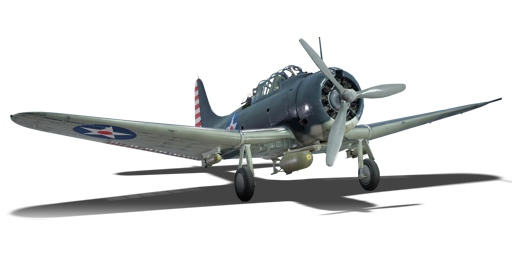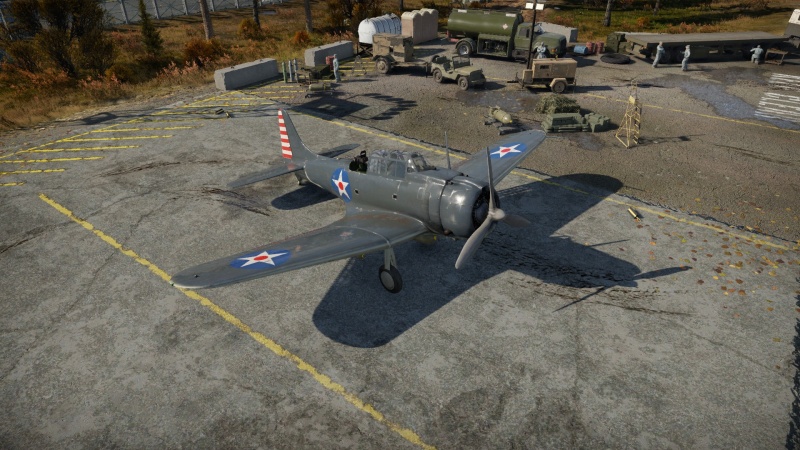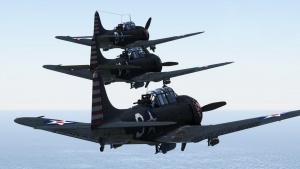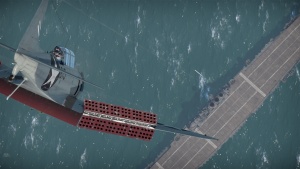SBD-3
Contents
Description
The SBD Dauntless was workhorse of US Navy, serving through 1940 all the way to late 1944 as main carrier based dive bomber. It replaced SBC Helldiver and SBU Corsair aboard US carriers. Featuring range of about 1700 km, quite heavy armament for its size and role, made of two 12.7 mm Browning M2 machine guns in engine cowling, and bombload of up to 2,250 lbs, it was very versatile plane. SBD participated in most of Pacific theater battles and achieved success such as sinking Japanese aircraft carrier Shōhō during the battle of the Coral Sea in May 1942, or its biggest success during Battle of Midway in June 1942 where SBD bombers sank four aircraft carriers. Namely Akagi, Kaga, Sōryū and Hiryū. The SBD was slowly being replaced in 1944 by faster and more modern SB2C Helldiver. Foreign users includes Royal Navy, Free French Airforce, Mexico, Chile and Morocco.
In War Thunder since the start of the Open Beta Test, the SBD-3 Dauntless is one of the first bombers in American aviation tech tree. Featuring an air spawn allowing for quick bombing runs out of reach of enemy fighters, as your bombs are dropped before the fighters climb up to your altitude. Heavy armament compared to contemporaries found in other tech trees allows for engaging enemy fighters using altitude advantage or after installation of DGP-1 machine gun pods, also engaging enemy medium and heavy bombers such as Fw-200, He-111 or Ju-88. Despite being a bomber, SBD is also quite manoeuverable aircraft, allowing to win prolonged turn fights with less agile opponents such as He-112 or MiG-3.
General info
Flight performance
As a dive bomber, it has very good dive characteristics and manoeuvres decently at most speeds. Although the engine is relatively weak, it could be WEP-ed for a long time before it reaches the overheating stage. This is not an aircraft which you will want to fly at high altitudes but should remain lower where it is a capable dive bomber.
| Characteristics | Max Speed (km/h at 4,500 m) |
Max altitude (metres) |
Turn time (seconds) |
Rate of climb (metres/second) |
Take-off run (metres) | |||
|---|---|---|---|---|---|---|---|---|
| AB | RB | AB | RB | AB | RB | |||
| Stock | 422 | 409 | 5700 | 26.6 | 27.8 | 7.9 | 7.8 | 291 |
| Upgraded | 456 | 439 | 24.3 | 25.5 | 14.3 | 9.8 | ||
Details
| Features | ||||
|---|---|---|---|---|
| Combat flaps | Take-off flaps | Landing flaps | Air brakes | Arrestor gear |
| ✓ | ✓ | ✓ | ✓ | ✓ |
| Limits | ||||||
|---|---|---|---|---|---|---|
| Wings (km/h) | Gear (km/h) | Flaps (km/h) | Max Static G | |||
| Combat | Take-off | Landing | + | - | ||
| 740 | 450 | 490 | 469 | 320 | ~13 | ~13 |
| Optimal velocities (km/h) | |||
|---|---|---|---|
| Ailerons | Rudder | Elevators | Radiator |
| < 350 | < 350 | < 380 | > 299 |
| Compressor (RB/SB) | ||
|---|---|---|
| Setting 1 | ||
| Optimal altitude | 100% Engine power | WEP Engine power |
| 1,324 m | 950 hp | 1,000 hp |
| Setting 2 | ||
| Optimal altitude | 100% Engine power | WEP Engine power |
| 4,777 m | 800 hp | 842 hp |
Engine performance
| Engine | |||||
|---|---|---|---|---|---|
| Engine Name | Number present | ||||
| Wright Cyclone R-1820-52 9-cylinder | 1 | ||||
| Engine characteristics | |||||
| Weight (each) | Type | Cooling | |||
| 907 kg | Radial | Air | |||
| Engine power (Stock) | |||||
| Mode | Max | Take-off | |||
| Arcade | 889 hp | 939 hp | |||
| Realistic/Simulator | 879 hp | 930 hp | |||
| Engine power (Upgraded) | |||||
| Mode | Max | Take-off | |||
| Arcade | 1,023 hp | 1,074 hp | |||
| Realistic/Simulator | 950 hp | 1,000 hp | |||
| WEP Duration | |||
|---|---|---|---|
| Arcade | Realistic/Simulator | ||
| 25 seconds | Infinite | ||
Survivability and armour
- 38 mm bulletproof glass in the windshield
- 12.7 mm steel pilot seat
- 12.7 mm steel protecting the gunner
- Self-sealing fuel tanks (2 in each wing)
Modifications and economy
Armaments
Offensive armament
The SBD-3 is armed with:
- 2 x 12.7 mm M2 Browning machine guns, nose-mounted (180 rpg = 360 total)
Suspended armament
The SBD-3 can be outfitted with the following ordnance:
- 1 x 1,000 lb AN-M65A1 bomb + 2 x 100 lb AN-M30A1 bombs (1,200 lb total)
- 4 x 12.7 mm M2 Browning machine guns, wing-mounted (gunpods) (340 rpg = 1,360 total)
- 1 x Type A Mark I mine
Defensive armament
The SBD-3 is defended by:
- 2 x 7.62 mm Browning machine guns, dorsal turret (1,000 rpg = 2,000 total)
Usage in battles
The Dauntless is an underrated aircraft, as it is viewed as a weak and sluggish bomber by a majority of tier 1 players. Use this to your advantage by catching unsuspecting bombers and fighters. Its manoeuvrability is good enough to energy fight the enemy. You should try to keep your speed higher than 200 km/h and stay at altitudes lower than 2km.
This plane is good at what it was designed for Dive Bombing. Start at a high altitude at around 4-5,000 feet, fly directly above the target, invert the plane, cut the throttle and deploy airbrakes (H key by default), dive, at 1,000-700 feet release bombs, pull the nose up, retract air brakes, push the throttle to full, then pitch up in a climb.
The small bomb load requires you pick your targets carefully and make your bombs count, choose to attack artillery positions or bases, where you have a higher chance of hitting due to their stationary position. Ships are also prime targets (it is what it was designed for), as the 1000lb bomb is plenty to sink a small ship.
Do not rely on fighter support when focusing on ground targets. After you drop your bombs, the plane should be manoeuvrable enough to dogfight enemies. You should stay on deck and manoeuvre wisely to not expose your weak underbelly. If you are caught at high altitude, go into a steep dive until you are at the deck, there is a good chance you may out dive them. If you cannot lose the enemy, try to quickly turn to your enemy's direction. your high G tolerance is equal, if not better than most enemies so you could lose them if they cant follow your turn.
Realistic battles
With the gun pods attached, you could act as menacing fighter support. With a high altitude spawn, try to hunt bombers first before you consider killing fighters. climb up to 4,500 m to get your max speed so you can dive down to the bombers. After eliminating a bomber or two, you should find that your allies are starting to engage the enemy. You could help them by catching enemies that are turning, have low speed, or attacking an ally. It should be easy to do all of this because of your energy advantage. You are still marked as a bomber, so enemies will surely consider you as an easy kill. You can not outrun them, but you can turn very well at almost every speed except stall. If they are coming from behind, a sudden reverse would be a good manoeuvre to throw them off. After that, you could either perform a head-on or fly under the enemy to avoid them. Avoid rushing upwards to maintain speed. Combine all of that with good trigger discipline, it is possible to achieve a five kill game.
Simulator battles
Hands-off carrier take-off (Auto engine control): Start the engine, flaps: raised, elevator trim: 15%, aileron trim: 11%, rudder trim: 6%, WEP throttle, hands-off controls until you lift off the carrier.
Enemies worth noting
Yak-2 KABB: Do not think that the SBD-3 can confidently outmanoeuvre this plane just because it is twin-engined. The Yak-2 has an amazing turn rate for a heavy fighter, thus the SBD-3 must avoid turning with it, if not dogfighting with it in general. It bears a pair of ShVAK cannons that can easily damage vital parts like engine or cooling systems. It has green camo, greatly resembling an Me 410 but with an H-tail like a Bf 110's.
Facing the SBD
It is very common in the game to encounter the SBD equipped with the gunpods, instead of its more usual historical role as a dive bomber. If you are playing against the Americans, in a battle rating where you are likely to encounter it, and especially if you are on a base-bombing run, it is wise to assume that you are facing six forward-firing .50 cal M2 machine guns, until proven otherwise. The best countermeasures are altitude, speed, and manoeuvrability.
Manual Engine Control
| MEC elements | ||||||
|---|---|---|---|---|---|---|
| Mixer | Pitch | Radiator | Supercharger | Turbocharger | ||
| Oil | Water | Type | ||||
| Controllable | Controllable Not auto controlled |
Controllable Auto control available |
Controllable Auto control available |
Separate | Controllable 2 gears |
Not controllable |
Pros and cons
Pros:
- Gets a bomber spawn which really makes up for its performance
- Can turn with most enemy fighters on its rank
- It has two powerful machine guns that are centrally mounted, meaning you can effectively hunt down low-tier bombers and in most situations, be a quasi-fighter aircraft
- Its bombs are powerful enough to destroy packed enemy ground vehicles
- Its manoeuvrability is good enough to attack enemy bombers and support friendly fighters
- Tail gunner has excellent coverage, almost a perfect 180 degrees on a horizontal plane
- Can "pullout" from a 60-degree dive quite effectively
- Tail gun also has plenty of ammunition
- Can be used as a fighter when needed
- Can increase the total firepower to 6 .50 cals, one of the earliest plane that has six M2 Brownings
- Good firepower, enough to make quick kills on planes and ground targets alike. Extremely useful for attacking weakly armoured tanks
- Decent dive characteristics
- Will not break its wing on high G turns up to 600 km/h
Cons:
- It is still a dive bomber, so its manoeuvrability is limited by its poor energy retention
- Low ammo capacity for the nose-mounted machine guns
- The tail gunner won't do so much, because he is too exposed and the 2 x 7.62 is not powerful enough to destroy planes of its tier
- Limited selection of bombs, only one payload is available to choose from
- Slow acceleration
- Poor climb rate
- Poor energy retention
- Slow speed
- WEP only works on low altitude
- Unprotected engine, any gunfire get your engine knocked out or badly damaged, forcing you to return to base
History
First flight recorded 1st of may 1940. Retired 1959. Produced from 1940 to 1944. Top speed of 410 km/h (255 mph). 1,200 hp engine. Length: 33 feet. Wing span is roughly 41 feet. Empty weight: 2,905 kg (6,404 lb). Gross weight is 4,245 kg (10,400 lb). Bomb load is 544 kg (1,200 lb).
The SBD-3, also known as the Dauntless is an American dive-bomber from the early 1940s. It was a carrier-based aircraft which was used for scouting and bombing. This plane is most famous for its contribution to the Battle of Midway. This battle was the first major naval victory for the Americans, of which four Japanese carriers were sunk and multiple other ships heavily damaged and sunk.
Pilots and gunners of the SBD-3 and other military personnel gave the bomber the nickname "Slow But Deadly". Although this plane was slow, it has a large wing area and thus high manoeuvrability. This aircraft is a 2-man crew, so when going into and out of a dive the pilot wouldn't have to check the altitude saving him time, though that was not the only use of the gunner/radioman he would cover the pilot, engaging any enemy fighters who would come behind the aircraft and could also double as a radioman.
These incredible planes all saw service in the United States Navy, United States Army Air Corps, United States Marine Corps and the Free French Air Force. There were 5,936 SBD-3 made; unfortunately, only four or five original US Navy planes survive today with the rest being replicas.
| Archive of the in-game description | |
|---|---|
|
A carrier-based dive-bomber/reconnaissance aircraft. The most well-known U.S. Navy bomber, and perhaps the most significant dive-bomber of the war. Despite the fact that the decision to write off the SBD as outdated was made before the war, the bomber was still actively involved in combat, and in 1942 it sunk more enemy ships than all other Navy aircraft combined. Originally, the series was called the XBT, and showed as many innovations as it did drawbacks. This aircraft had a revolutionary honeycomb wing structure and a reasonably small fuselage. But its wings could not be folded, and occasionally it would spontaneously go into a barrel roll, which caused a series of catastrophic accidents. After intensive research in conjunction with NACA, the dive-bomber was radically redesigned, most of its shortcomings were removed, and it was named the Scout Bomber. The SBD-3 variant was a Scout Bomber which was finally fit for combat. It had self-sealing fuel tanks, armour, and bulletproof cockpit glass. To keep its performance characteristics, the aircraft's weight was reduced by replacing its duralumin sheeting with a much lighter material. Also, all the equipment designed to keep the plane afloat in the event of a water landing was removed. Soldiers dubbed the SBD the "Slow But Deadly". This aircraft destroyed the pride of the Japanese carrier force at the Battle of Midway, inflicting damage from which the Japanese Imperial Navy was never able to recover. | |
Media
- Skins
- Videos
See also
- Aircraft of comparable role, configuration and era
External links
- [Profile] SBD-3 Dauntless - Slow But Deadly
- Official data sheet - more details about the performance
| Douglas Aircraft Company | |
|---|---|
| Strike Aircraft | A-20G-25 · A-26B-10 · A-26B-50 · AD-2 · AD-4 · A-1H |
| Bombers | TBD-1 · B-18A · SBD-3 · BTD-1 · A-26C-45 · A-26C-45DT |
| Turboprops | A2D-1 |
| Jet Aircraft | F3D-1 · F4D-1 |
| A-4 Skyhawk | A-4B · A-4E Early |
| Export | ▄Havoc Mk I · ▄Boston Mk I · ▄DB-7 · ▂A-20G-30 · ▄AD-4 · ▄AD-4NA |
| A-4 Skyhawk | A-4H · A-4E Early (M) · Ayit · A-4E |
| The Douglas Aircraft Company merged with McDonnell Aircraft Corporation in 1967 to form McDonnell Douglas. | |
| USA bombers | |
|---|---|
| Dive | SB2U-2 · SB2U-3 · SBD-3 · SB2C-1C · SB2C-4 |
| Torpedo | TBD-1 · PBY-5 Catalina · PBY-5A Catalina · TBF-1C · BTD-1 |
| Medium | B-10B · B-18A · B-34 · PV-2D · B-25J-1 · B-25J-20 · A-26C-45 · A-26C-45DT · B-26B |
| Heavy | B-17E · B-17E/L · B-17G-60-VE · PB4Y-2 · B-24D-25-CO · B-29A-BN |
| Hydroplanes | OS2U-1 · OS2U-3 · PBM-1 "Mariner" · PBM-3 "Mariner" · PBM-5A "Mariner" |







